August 29 marked the first day of a new fall semester at Texas A&M University and the official launch of the Science Leadership Scholars (SLS) Program, a newly established educational effort within the College of Science intended to improve student retention and undergraduate success through early intervention -- from the moment students first set foot on campus.
 Texas A&M Science Associate Dean for Undergraduate Programs and Development Timothy P. Scott dispenses study tips and other expert advice during the orientation's academic boot camp session intended to help the scholars transition from high school to university life.
Texas A&M Science Associate Dean for Undergraduate Programs and Development Timothy P. Scott dispenses study tips and other expert advice during the orientation's academic boot camp session intended to help the scholars transition from high school to university life.
Like these students, Meigan Aronson also had many goals when she first arrived in Aggieland as Dean of Science last fall, none bigger than embracing Texas A&M's land-grant mission to provide access to affordable, high-quality education for any student willing to rise to the challenge. And like any good scientist, she came equipped with facts -- namely, state and national research indicating that classroom performance among today's college students follows predictable patterns. In addition to the traditional bell curve, Aronson notes there is a second grade distribution encompassing otherwise high-performing students who, independent of solid ACT/SAT scores and high school achievement, typically remain at risk for a variety of reasons, particularly at a university as large as Texas A&M and in such rigorous disciplines as science and mathematics.
"We wanted to make a concentrated effort to help a pivotal pilot group of determined, academically solid, yet otherwise at-risk students beat the odds that suggest collegiate success may not be in their future," Aronson said. "Our goal was to get involved long before there is a problem and put them on a track that ensures they are set up to thrive at Texas A&M and as majors within the College of Science."
The inaugural SLS class features 23 freshmen recruited primarily for their past academic achievement and future potential but also because they share common risk factors, including being first-generation, low-income students majoring in mathematics and science.
"Based on a New York Times article titled Who Gets to Graduate?, research showed that if students had two of these markers -- first-generation, low-income, historically underrepresented minority and female -- their chance of actually graduating from university was about 50 percent relative to the upper distribution," Aronson said. "Fifty percent. And if they were to graduate, it would take them about 50 percent longer. That was a social issue that I felt I could do something about."
Watch the Science Leadership Scholars complete a team-building exercise in which everyone had to hold a string attached to a single metal ring and then work together to transport a tennis ball from a mount on one side of the room, step through a hula hoop, and finally place the tennis ball on a mount on the other side of the room -- all without dropping the ball or letting go of their string!
Timothy P. Scott, associate dean for undergraduate programs and development in Texas A&M Science, worked throughout the spring and summer to identify and recruit high-achieving prospective students interested in majoring in degree programs across the college's five departments and also serving as pioneers in a new phase of immersive success and leadership development.
"Make no mistake, this is a unique and prestigious academic scholarship," Scott said. "We were going after some of the best and brightest among our top recruits with the promise that we would come alongside them to increase our retention and graduation rates and ensure their ultimate success in the process."
Scott says one of the program's biggest keys is providing assistance to these students during the critical first year as they make the transition from high school to Texas A&M -- not only in the form of academic resources but also through social support that all students need, regardless of background and circumstances.
 One of the highlights of academic boot camp was a student panel Q&A session featuring current Texas A&M Science undergraduate students.
One of the highlights of academic boot camp was a student panel Q&A session featuring current Texas A&M Science undergraduate students.
"If you are first-gen, you can't pick up the phone and ask Mom and Dad what to do," Scott said. "You have to have people who can stand in that gap, someone that students can contact with questions and concerns. We hope to be that someone and to provide both answers and resources through the Science Leadership Scholars Program."
In addition to Texas A&M Science funding, the program is underwritten by contributions through the Texas A&M Foundation from multiple members of the college's External Advisory & Development Council, including a lead gift from Barbara '82 and John Calhoun '79 and subsequent gifts from James Adams '61, Gina Dickerson '86 and Ronald Wilson '72. Each gift will be counted toward the goals of the university's Lead by Example comprehensive campaign, which aims to raise $4 billion by 2020 to solve the most crucial challenges facing the state, nation and world.
Beyond offering annual scholarships, Scott says the program will supplement the scholars' traditional classroom and laboratory education with weekly one-one-one and group meetings focused on building academic skills, fostering individual and group accountability, and promoting the value and variety of STEM careers as well as early research experiences. The overall structure is loosely patterned upon Scott's work as faculty mentor since 2014 for Texas A&M's Posse Foundation Scholars cohort, one of 70 nationwide that prepares 10 first-generation students per group to attend select colleges across the country. It also builds on best practices gleaned from his previous success with the Transfer Learning Community he founded in fall 2011 to assist all entering College of Science transfer students in their transition to Texas A&M from other colleges and universities -- model results included in the Barriers and Opportunities for 2-Year and 4-Year STEM Degrees: Systemic Change to Support Diverse Student Pathways and also published in the Journal of College Student Retention: Research, Theory & Practice.
Scott's solid track record in both mentorship arenas in combination with Aronson's goals and former student/industry support proved to be the driving force in recruiting one additional linchpin to the program: Gregory L. Square as SLS advisor and Texas A&M Science's first-ever undergraduate recruiter. He brings more than two decades in community college advising, on top of direct experience working with first-time in-college freshmen and leadership in building learning communities for traditionally underrepresented students.
"It's important to measure program success as well as individual success," Square said. "I have a huge passion for assessment, especially on the qualitative side. Early on in my one-on-one meetings with the scholars, I have incorporated a grid scale to help us determine how we can measure the ability of students to persist -- that characteristic of not giving up in the face of life's challenges. Of course, I'd argue that, not only are these students high achievers, they're probably some of the grittiest students we have on campus.
"I'm all about wanting to see how we can improve -- not only the program but how we can improve student success. That's my passion. I love the one-on-one with the students, and I love engaging with them. I think that is going to be the biggest thing I bring to the table -- connecting with the students and ensuring and assessing their success. I truly believe this can really alter their family generation from this point on and have a definite impact on where these kids go as well as their descendants."
 Scott, sharing final thoughts with the SLS group as they prepare to officially embark on their collegiate adventure as Texas A&M Science majors and Aggie undergraduates.
Scott, sharing final thoughts with the SLS group as they prepare to officially embark on their collegiate adventure as Texas A&M Science majors and Aggie undergraduates.
Scott notes that a critical component of the program is implicit in its name: leadership. Once the scholars hit their collegiate stride, he says the next step will be to hone their leadership skills, enabling them as a group and as individuals to define themselves as well as the future direction of the program as peer advisors for subsequent SLS cohorts.
"Part of their leadership experience will be sharing their collective wisdom and advice gained through the program as they help us to support new students in future years," Scott said. "That is an expectation of all scholars -- that they will pay it forward as we transition them through the program by working with the classes that come after them."
As the program's catalyst, Aronson says she is most excited by what she sees as a two-way learning opportunity with exponential benefits, both for the college and for all Texas A&M students who take fundamental science, mathematics and statistics courses through Texas A&M Science.
"I view the Science Leadership Scholars as a very special group of students selected first and foremost for their promise," Aronson said. "By starting out small, we can easily adapt and adjust this novel pilot program as necessary. The students themselves will show us what works through their successes and personification of leadership, ideally pointing the way to a scaled-up version that would in time address many more students, from those in the College of Science to the larger population that we serve through our gateway introductory courses impacting all Texas A&M students."
This article was originally published by the College of Science.
Texas A&M Foundation
The Texas A&M Foundation is a nonprofit organization that solicits and manages investments in academics and leadership programs to enhance Texas A&M’s capability to be among the best universities.